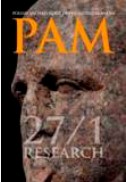Wall paintings from the House of Aion at Nea Paphos
Wall paintings from the House of Aion at Nea Paphos
Author(s): Elżbieta JastrzębowskaSubject(s): Archaeology, Architecture, Visual Arts, Ancient World
Published by: Wydawnictwa Uniwersytetu Warszawskiego
Keywords: Paphos; House of Aion; wall paintings; stratigraphy; muses; Thalia; Urania; Euterpe;
Summary/Abstract: This paper studies a collection of painted plaster fragments excavated between 1984 and 1989 in the northern part of the so-called House of Aion, that is, three small rooms (Nos 3, 13, 14, 15 and 7). The architectural context of these finds and their dating is first recapitulated: the house was constructed in the second half of the 4th century only to be demolished by a strong earthquake at the end of the century or the beginning of the following one. Most of the plaster pieces were small and of little significance in terms of the remaining colors, but a few from Room 7 were sufficiently well preserved to support a reconstruction of parts of five figural images (three muses, Apollo and a mask) and determine their hypothetical position in this room. Parallels, in painting and floor mosaics, range from Ephesos and Kos in the east to Vichen (Luxembourg) in the west. Based on the iconographic identification, the 4th century AD Muses from Paphos could be recognized as: a standing Thalia holding a mask, a seated Urania and a standing Euterpe with a double flute in her hand, accompanied by Apollo holding a lyre. Together they constituted typical decoration of a Mediterranean Roman house, common from the early Empire through late antiquity.
Journal: Polish Archaeology in the Mediterranean
- Issue Year: 1/2018
- Issue No: XXVII
- Page Range: 527-597
- Page Count: 72
- Language: English

